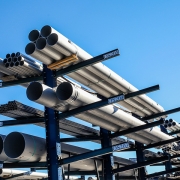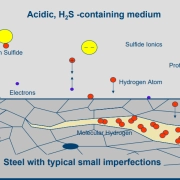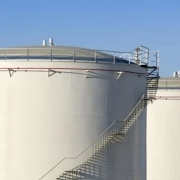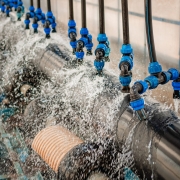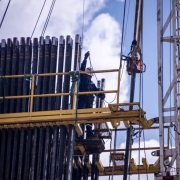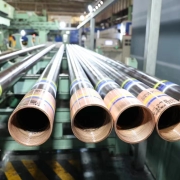Introduction
Steel pipes are critical in the oil and gas, offering unmatched durability and reliability under extreme conditions. Essential for exploration and transportation, these pipes withstand high pressures, corrosive environments, and harsh temperatures. This page explores the critical functions of steel pipes in oil and gas exploration, detailing their importance in drilling, infrastructure, and safety. Discover how selecting suitable steel pipes can enhance operational efficiency and reduce costs in this demanding industry.
I. The Basic Knowledge of the Steel Pipes for the Oil & Gas Industry
1. Terminology Explanation
API: Abbreviation of American Petroleum Institute.
OCTG: Abbreviation of Oil Country Tubular Goods, including Oil Casing Pipe, Oil Tubing, Drill Pipe, Drill Collar, Drill Bits, Sucker Rod, Pup joints, etc.
Oil Tubing: Tubing is used in oil wells for Extraction, gas extraction, water injection, and acid fracturing.
Casing: Tubing lowered from the ground surface into a drilled borehole as a liner to prevent wall collapse.
Drill Pipe: Pipe used for drilling boreholes.
Line Pipe: Pipe used to transport oil or gas.
Couplings: Cylinders used to connect two threaded pipes with internal threads.
Coupling Material: Pipe used for manufacturing couplings.
API Threads: Pipe threads specified by API 5B standard, including oil pipe round threads, casing short round threads, casing long round threads, casing partial trapezoidal threads, line pipe threads, etc.
Premium Connection: Non-API threads with unique sealing properties, connection properties, and other properties.
Failures: deformation, fracture, surface damage, and loss of original function under specific service conditions.
Primary Forms of Failure: crushing, slipping, rupture, leakage, corrosion, bonding, wear, etc.
2. Petroleum Related Standards
API Spec 5B, 17th Edition – Specification for Threading, Gauging, and Thread Inspection of Casing, Tubing, and Line Pipe Threads
API Spec 5L, 46th Edition – Specification for Line Pipe
API Spec 5CT, 11th Edition – Specification for Casing and Tubing
API Spec 5DP, 7th Edition – Specification for Drill Pipe
API Spec 7-1, 2nd Edition – Specification for Rotary Drill Stem Elements
API Spec 7-2, 2nd Edition – Specification for Threading and Gauging of Rotary Shouldered Thread Connections
API Spec 11B, 24th Edition – Specification for Sucker Rods, Polished Rods and Liners, Couplings, Sinker Bars, Polished Rod Clamps, Stuffing Boxes and Pumping Tees
ISO 3183:2019 – Petroleum and Natural Gas Industries — Steel Pipe for Pipeline Transportation Systems
ISO 11960:2020 – Petroleum and Natural Gas Industries — Steel Pipes for Use as Casing or Tubing for Wells
NACE MR0175 / ISO 15156:2020 – Petroleum and Natural Gas Industries — Materials for Use in H2S-Containing Environments in Oil and Gas Production
II. Oil Tubing
1. Classification of Oil Tubing
Oil Tubing is divided into Non-Upsetted Oil Tubing (NU), External Upsetted Oil Tubing (EU), and Integral Joint (IJ) Oil Tubing. NU oil tubing means that the end of the tubing is of average thickness, directly turns the thread, and brings the couplings. Upsetted tubing implies that the ends of both tubes are externally Upsetted, then threaded and coupled. Integral Joint tubing means that one end of the tube is Upset with external threads, and the other is Upset with internal threads connected directly without couplings.
2. Function of Oil Tubing
① Extraction of oil and gas: after the oil and gas wells are drilled and cemented, the tubing is placed in the oil casing to extract oil and gas to the ground.
② Water injection: when the downhole pressure is insufficient, inject water into the well through the tubing.
③ Steam injection: In thick oil hot recovery, steam is input into the well with insulated oil tubing.
④ Acidification and fracturing: In the late stage of well drilling or to improve the production of oil and gas wells, it is necessary to input Acidification and fracturing medium or curing material to the oil and gas layer, and the medium and the curing material are transported through the oil tubing.
3. Steel Grade of Oil Tubing
The steel grades of oil tubing are H40, J55, N80, L80, C90, T95, P110.
N80 is divided into N80-1 and N80Q, the two have the same tensile properties; the two differences are the delivery status and impact performance differences, N80-1 delivery by normalized state or when the final rolling temperature is greater than the critical temperature Ar3 and tension reduction after air cooling and can be used to find hot rolling instead of normalized, impact and non-destructive testing are not required; N80Q must be tempered (quenched and tempered) Heat treatment, impact function should be in line with the provisions of API 5CT, and should be non-destructive testing.
L80 is divided into L80-1, L80-9Cr and L80-13Cr. Their mechanical properties and delivery status are the same. Differences in use, production difficulty, and price: L80-1 is for the general type, L80- 9Cr and L80-13Cr are high corrosion resistance tubing, production difficulty, and are expensive and usually used in heavy corrosion wells.
C90 and T95 are divided into 1 and 2 types, namely C90-1, C90-2 and T95-1, T95-2.
4. The Oil Tubing Commonly Used Steel Grade, Steel Name and Delivery Status
J55 (37Mn5) NU Oil Tubing: Hot rolled instead of Normalised
J55 (37Mn5) EU Oil Tubing: Full-length Normalized after upsetting
N80-1 (36Mn2V) NU Oil Tubing: Hot-rolled instead of Normalised
N80-1 (36Mn2V) EU Oil Tubing: Full-length Normalized after upsetting
N80-Q (30Mn5) Oil Tubing: 30Mn5, Full-length Tempering
L80-1 (30Mn5) Oil Tubing: 30Mn5, Full-length Tempering
P110 (25CrMnMo) Oil Tubing: 25CrMnMo, Full-length Tempering
J55 (37Mn5) Coupling: Hot rolled on-line Normalised
N80 (28MnTiB) Coupling: Full-length Tempering
L80-1 (28MnTiB) Coupling: Full-length Tempered
P110 (25CrMnMo) Coupling: Full-length Tempering
III. Casing Pipe
1. Classification and Role of Casing
The casing is the steel pipe that supports the wall of oil and gas wells. Several layers of casing are used in each well according to different drilling depths and geological conditions. Cement is used to cement the casing after it is lowered into the well, and unlike oil pipe and drill pipe, it cannot be reused and belongs to disposable consumable materials. Therefore, the consumption of casing accounts for more than 70 percent of all oil well pipes. The casing can be divided into conductor casing, intermediate casing, production casing, and liner casing according to its use, and their structures in oil wells are shown in Figure 1.
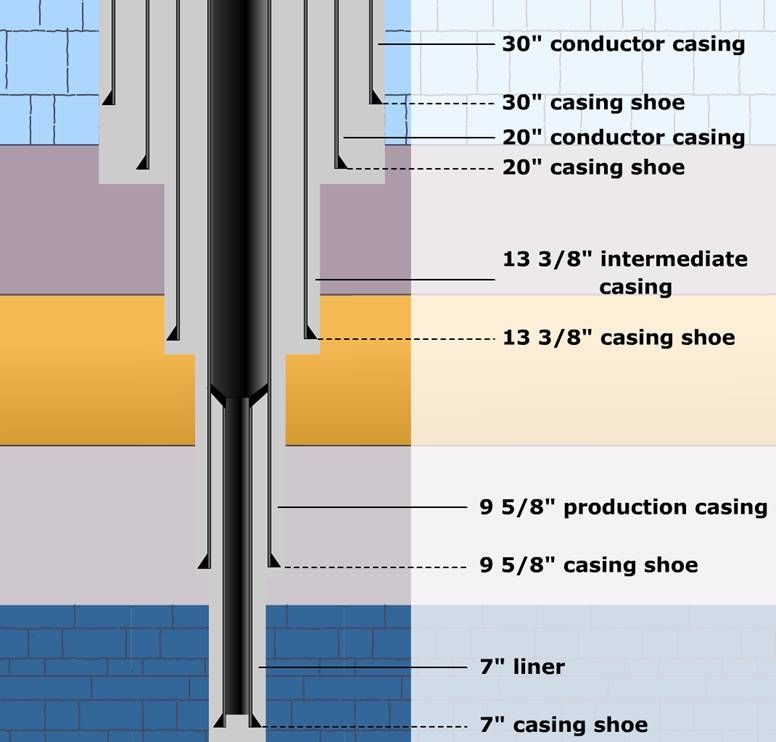
①Conductor Casing: Typically using API grades K55, J55, or H40, conductor casing stabilizes the wellhead and isolates shallow aquifers with diameters commonly around 20 inches or 16 inches.
②Intermediate Casing: Intermediate casing, often made from API grades K55, N80, L80, or P110, is used to isolate unstable formations and varying pressure zones, with typical diameters of 13 3/8 inches, 11 3/4 inches, or 9 5/8 inches.
③Production Casing: Constructed from high-grade steel such as API grades J55, N80, L80, P110, or Q125, production casing is designed to withstand production pressures, commonly with diameters of 9 5/8 inches, 7 inches, or 5 1/2 inches.
④Liner Casing: Liners extend the wellbore into the reservoir using materials like API grades L80, N80, or P110, with typical diameters of 7 inches, 5 inches, or 4 1/2 inches.
⑤Tubing: Tubing transports hydrocarbons to the surface, using API grades J55, L80, or P110, and is available in diameters of 4 1/2 inches, 3 1/2 inches, or 2 7/8 inches.
IV. Drill pipe
1. Classification and Function of Pipe for Drilling Tools
The square drill pipe, drill pipe, weighted drill pipe, and drill collar in drilling tools form the drill pipe. The drill pipe is the core drilling tool that drives the drill bit from the ground to the bottom of the well, and it is also a channel from the ground to the bottom of the well. It has three leading roles:
① To transmit torque to drive the drill bit to drill;
② To rely on its weight to the drill bit to break the pressure of the rock at the bottom of the well;
③ To transport washing fluid, that is, drilling mud through the ground through the high-pressure mud pumps, drilling column into the borehole flow into the bottom of the well to flush the rock debris and cool the drill bit, and carry the rock debris through the outer surface of the column and the wall of the well between the annulus to return to the ground, to achieve the purpose of drilling the well.
The drill pipe is used in the drilling process to withstand a variety of complex alternating loads, such as tensile, compression, torsion, bending, and other stresses. The inner surface is also subject to high-pressure mud scouring and corrosion.
(1) Square Drill Pipe: Square drill pipes come in two types: quadrilateral and hexagonal. In China’s petroleum drill pipe, each set of drill columns usually uses a quadrilateral type drill pipe. Its specifications are 63.5mm (2-1/2 inches), 88.9mm (3-1/2 inches), 107.95mm (4-1/4 inches), 133.35mm (5-1/4 inches), 152.4mm (6 inches), and so on. The length used is usually 1214.5 m.
(2) Drill Pipe: The drill pipe is the primary tool for drilling wells, connected to the lower end of the square drill pipe, and as the drilling well continues to deepen, the drill pipe keeps lengthening the drill column one after another. The specifications of drill pipe are: 60.3mm (2-3/8 inches), 73.03mm (2-7/8 inches), 88.9mm (3-1/2 inches), 114.3mm (4-1/2 inches), 127mm (5 inches), 139.7mm (5-1/2 inches) and so on.
(3) Heavy Duty Drill Pipe: A weighted drill pipe is a transitional tool connecting the drill pipe and drill collar, which can improve the force condition of the drill pipe and increase the pressure on the drill bit. The main specifications of the weighted drill pipe are 88.9mm (3-1/2 inches) and 127mm (5 inches).
(4) Drill Collar: The drill collar is connected to the lower part of the drill pipe, which is a special thick-walled pipe with high rigidity. It exerts pressure on the drill bit to break the rock and plays a guiding role when drilling a straight well. The common specifications of drill collars are 158.75mm (6-1/4 inches), 177.85mm (7 inches), 203.2mm (8 inches), 228.6mm (9 inches), and so on.
V. Line pipe
1. Classification of Line Pipe
Line pipe is used in the oil and gas industry to transmit oil, refined oil, natural gas, and water pipelines with the abbreviation of steel pipe. Conveying oil and gas pipelines is divided into mainline, branch, and urban pipeline network pipelines. Three kinds of mainline pipeline transmission have the usual specifications of ∅406 ~ 1219mm, a wall thickness of 10 ~ 25mm, steel grade X42 ~ X80; branch line pipeline and urban pipeline network pipelines usually have specifications for ∅114 ~ 700mm, the wall thickness of 6 ~ 20mm, the steel grade for the X42 ~ X80. The steel grade is X42~X80. Line pipe is available in welded and seamless types. Welded Line Pipe is used more than Seamless Line Pipe.
2. Standard of Line Pipe
API Spec 5L – Specification for Line Pipe
ISO 3183 – Petroleum and Natural Gas Industries — Steel Pipe for Pipeline Transportation Systems
3. PSL1 and PSL2
PSL is the abbreviation for product specification level. The specification level of the line pipe product is divided into PSL 1 and PSL 2, and the quality level is divided into PSL 1 and PSL 2. PSL 2 is higher than PSL 1; the two specification levels not only have different test requirements, but the chemical composition and mechanical properties requirements are different, so according to API 5L order, the terms of the contract, in addition to specifying the specifications, steel grade, and other common indicators, but also must indicate the product Specification level, that is, PSL 1 or PSL 2. PSL 2 in the chemical composition, tensile properties, impact power, non-destructive testing, and other indicators are stricter than PSL 1.
4. Line Pipe Steel Grade, Chemical Composition and Mechanical Properties
Line pipe steel grades from low to high are divided into A25, A, B, X42, X46, X52, X60, X65, X70, and X80. For detailed Chemical Composition and Mechanical Properties, please refer to the API 5L Specification, 46th Edition Book.
5. Line Pipe Hydrostatic Test and Non-destructive Examination Requirements
Line pipe should be done branch by branch hydraulic test, and the standard does not allow non-destructive generation of hydraulic pressure, which is also a big difference between the API standard and our standards. PSL 1 does not require non-destructive testing; PSL 2 should be non-destructive testing branch by branch.
VI. Premium Connections
1. Introduction of Premium Connections
Premium Connection is a pipe thread with a unique structure that is different from the API thread. Although the existing API threaded oil casing is widely used in oil well exploitation, its shortcomings are clearly shown in the unique environment of some oil fields: the API round threaded pipe column, although its sealing performance is better, the tensile force borne by the threaded part is only equivalent to 60% to 80% of the strength of the pipe body, and thus it can’t be used in the exploitation of deep wells; the API biased trapezoidal threaded pipe column, although its tensile performance is much higher than that of the API round threaded connection, its sealing performance is not so good. Although the tensile performance of the column is much higher than that of the API round thread connection, its sealing performance is not very good, so it can not be used in the exploitation of high-pressure gas wells; in addition, the threaded grease can only play its role in the environment with the temperature below 95℃, so it can not be used in the exploitation of high-temperature wells.
Compared with the API round thread and partial trapezoidal thread connection, the premium connection has made breakthrough progress in the following aspects:
(1) Good sealing, through the elasticity and metal sealing structure design, makes the joint gas sealing resistant to reaching the limit of the tubing body within the yield pressure;
(2) High strength of the connection, connecting with special buckle connection of oil casing, its connection strength reaches or exceeds the strength of the tubing body, to solve the problem of slippage fundamentally;
(3) By the Material selection and surface treatment process improvement, basically solved the problem of thread sticking buckle;
(4) Through the optimization of the structure, so that the joint stress distribution is more reasonable and more conducive to the resistance to stress corrosion;
(5) Through the shoulder structure of the reasonable design, so that the operation of the buckle on the operation is more accessible.
The oil and gas industry boasts over 100 patented premium connections, representing significant advancements in pipe technology. These specialized thread designs offer superior sealing capabilities, increased connection strength, and enhanced resistance to environmental stresses. By addressing challenges such as high pressures, corrosive environments, and temperature extremes, these innovations ensure excellent reliability and efficiency in oil-healthy operations worldwide. Continual research and development in premium connections underscore their pivotal role in supporting safer and more productive drilling practices, reflecting an ongoing commitment to technological excellence in the energy sector.
VAM® Connection: Known for its robust performance in challenging environments, VAM® connections feature advanced metal-to-metal sealing technology and high torque capabilities, ensuring reliable operations in deep wells and high-pressure reservoirs.
TenarisHydril Wedge Series: This series offers a range of connections such as Blue®, Dopeless®, and Wedge 521®, known for their exceptional gas-tight sealing and resistance to compression and tension forces, enhancing operational safety and efficiency.
TSH® Blue: Designed by Tenaris, TSH® Blue connections utilize a proprietary double shoulder design and a high-performance thread profile, providing excellent fatigue resistance and ease of make-up in critical drilling applications.
Grant Prideco™ XT® Connection: Engineered by NOV, XT® connections incorporate a unique metal-to-metal seal and a robust thread form, ensuring superior torque capacity and resistance to galling, thereby extending the connection’s operational life.
Hunting Seal-Lock® Connection: Featuring a metal-to-metal seal and a unique thread profile, the Seal-Lock® connection by Hunting is renowned for its superior pressure resistance and reliability in both onshore and offshore drilling operations.
Conclusion
In conclusion, the intricate network of steel pipes crucial to the oil and gas industry encompasses a wide array of specialized equipment designed to withstand rigorous environments and complex operational demands. From the foundational casing pipes that support and protect healthy walls to the versatile tubing used in extraction and injection processes, each type of pipe serves a distinct purpose in exploring, producing, and transporting hydrocarbons. Standards like API specifications ensure uniformity and quality across these pipes, while innovations such as premium connections enhance performance in challenging conditions. As technology evolves, these critical components advance, driving efficiency and reliability in global energy operations. Understanding these pipes and their specifications underscores their indispensable role in the modern energy sector’s infrastructure.

